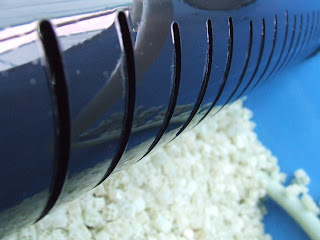The first item of the day is always feeding the fish and taking time to watch them, yes, enjoy them, and make sure they're all ok. Then filter screen cleans.
Then fixing a door into the new lean-to area next to the tosai house. It had been sticking a bit and needed some trimming around the edge of its corrugated plastic covering. This was achieved with an angle grinder using a thin disc (so the plastic didn't shatter). I also got to see the 4" stone disc (used for making the slits in the filter pipes - below) and a diamond disc used for cutting stone.
After tea-break, I got on with some cleaning while Mark attended to some customers. The tosai house (for those who don't know it) is rather large. It has a big, white ceiling and large, white walls. In the past few years since the tosai house has been up and running, these had begun to look a little grimy. Not lots grimy - on any other colour but white, you'd probably not notice, but attention to detail is key and making the area look inviting is an important part of making a sale (which is why the sales area is so pretty). So I was kitted up with a bucket and mop and I mopped that ceiling. Much harder work than you'd think and quite a lot of effort, working with both hands above my head for so long. I was pleased with the job I did though, and it was very satisfying to see how much of an impact I'd made.
We then did some netting and counting. Mark showed me how to net all of the fish in a 9 tonne tank in one fell swoop and then went to buy new light bulbs whilst I counted them back in (the customers from earlier had bought 300, another person wanted 200 and someone else wanted however many were left, so numbers needed to be confirmed. So I spent a happy half hour or so with a scoopy net and a clicker enjoying the shapes and patterns of the tiny, shiny fish as I counted them back in.
After lunch, more netting this time to move fish around. Fish with colour need light (either daylight or light with equivalent qualities) to help their colour develop and be strong and beautiful. So colourful fish were moved to a tank with a halide lamp and a number of the black-and-white shiro utsuris were moved to a tank without a light. Some of the larger fish were moved to a tank which had fewer, larger fish in it (to balance out the numbers in the tanks) and a few of the smallest fish were moved into yet another tank containing some of the late spawnings (further small fish).
The most memorable moment was when I was netting off and separating the showas, kohakus and yamato nishikis from the shiro utsuris and the odd shiro bekko and Mark wandered over and asked "Are you spending time looking at them?" I replied that no, I wasn't, not really, and he very quickly responded "Well you should be - it's important to develop your appreciation of them."
Lesson learned - effectiveness in breeding top quality koi isn't all about speed and efficiency.


No comments:
Post a Comment